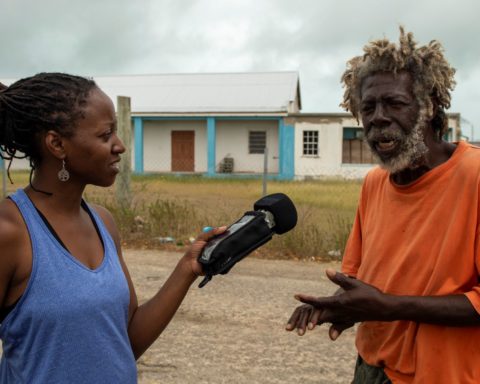CBC/Radio-Canada
In late April 2013, first-time independent documentary filmmakers Fiona Rayner and Damien Gillis travelled from their home province of British Columbia to the Hot Docs Forum in Toronto. Their one-off, point-of-view documentary proposal Fractured Land, featuring a young First Nations law student named Caleb Behn, had been selected as one of the projects to be pitched at Hot Docs’ high-profile two-day pitch session. Seated before dozens of international broadcasters, in addition to scores of fascinated observers perched in the bleachers at the University of Toronto’s Hart House, Rayner and Gillis were at the Forum with the hope of securing the financing required to move their documentary beyond the development phase. According to EyeSteelFilm president and Hot Docs Forum pitch veteran Daniel Cross, a successful pitch by an independent producer at the Forum “lets everyone know how much you care [about your project] and how much you’ve invested…it attracts partners.”
Seated shoulder-to-shoulder with Rayner and Gillis at the Hot Docs Forum producer pitch table was Bruce Cowley, creative head of the Canadian digital specialty service documentary. A documentary-focused pay-subscription service that commissions roughly 12 independent documentaries per year, documentary is a partnership that reported 2.7 million subscribers to the CRTC in 2012 and has been 82 percent owned by CBC/Radio-Canada since 2007. The NFB/ONF owns 14 percent of the service and the balance is owned by four independent production companies. While CBC/Radio-Canada holds a majority ownership stake in documentary, Cowley notes that the service does not receive an annual government allocation and that “programming dollars that we use for documentary film production come from our subscriber revenue and ad sales.”
Cowley supported Fractured Land with a development licence after learning about the proposal from Rayner at the Banff World Media Festival in 2012. His appearance alongside Rayner and Gillis at the Hot Docs Forum a year later represented a collective effort to secure the international funding support required to fill the $100,000-plus gap in the project’s proposed production budget. “We’re trying to do our part to keep the documentary genre chugging along,” notes Cowley. “We’ve seen our subscriber base grow over the years, and because of that we’re producing more films now than we were five years ago. I get calls from [independent producers] probably 10 or 15 times per week.”
When asked months later whether the flight to Toronto for the Hot Docs Forum was worth it, Rayner notes how “people who I wanted to talk to at the IDFA (International Documentary Filmfestival Amsterdam) Forum were all over us and very interested in our film.” Fractured Land was awarded the grassroots Cuban Hat Award as the best Hot Docs Forum pitch, further punctuating the positive response to their documentary presentation.
While the commissioning of one-off independently-produced projects at the specialty channel documentary has increased over the past five years, the same trend has not extended to the publicly funded main CBC/Radio-Canada television network. Describing one-off Canadian documentary as “essential to a democratic dialogue,” Mark Starowicz, Executive Director of Documentary Programming at CBC Television, notes that 70 percent of CBC documentaries are independently produced and that Canada’s public broadcaster is one of the last conventional broadcasters that supports one-off documentary production.
Click here to read the first part of The Dangling Conversation.
“The [other] main terrestrial networks, CTV and Global, are not significant players in the one-off documentary area,” notes Starowicz. “We spend millions of dollars a year on documentary. We’re still the only institution that has two hours of documentaries in prime time nationally on Thursday nights, back to back [The Nature of Things and Doc Zone].” However, Starowicz admits that “the funding of documentaries has become more difficult over the last five to eight years.” As noted by Starowicz, “CMF [Canada Media Fund] funding that’s available to CBC has seriously declined over the years. As the CBC is a major producer of documentaries, the less access we have to CMF money, the less we’re going to produce. Our budgets have gone down drastically over the years. We just got a [$115 million] cut last year. We had to cut 40 percent of the documentary department’s staff, which wasn’t too big to begin with anyway. That affects our licence fees.”
While Daniel Cross agrees that the CBC does need more CMF funds, he feels there remains a structural problem in terms of funding Canadian documentary. “The CMF needs to help [CBC] more but CMF is locked on [to the concept that for each documentary] you have to have a broadcaster. There’s a lot of stories of people who got the [CMF’s] POV Fund or the Experimental Fund and couldn’t lock their CMF money because they had no broadcaster. That establishes that it’s very hard to get a Canadian commission.”
In terms of the current main CBC network’s documentary strands, Cross notes that “The Nature of Things and Doc Zone, as important as they are, are a different beast. What we’ve lost is The Lens or Rough Cuts.” According to CBC/Radio-Canada, the since-cancelled documentary strands The Lens and Rough Cuts together commissioned approximately 175 one-off POV Canadian documentaries between 1994 and 2009. Cross notes a crucial difference in style of one-off strands like The Lens and Rough Cuts that “didn’t have hosts. Young filmmakers were able to access them; first-time filmmakers were able to access them. It was that type of storytelling.”
Scheduling is also a concern for Cross. While he applauds CBC’s commissioning of EyeSteelFilm’s award-winning documentary Up the Yangtze, he was disappointed in the scheduling of the work. “It went on [CBC’s Newsworld channel, now CBC News Network] The Passionate Eye and it was great…[but we wanted to know]: ‘Why don’t you put Up the Yangtze on the main channel?’ [They said] there’s no place for it. In the summer you can watch Happy Gilmore on the main channel. I don’t know what that’s about.” As for the commissioning to independents being done by documentary, Cross notes that “the documentary channel is getting better. Bruce [Cowley] is actively developing projects. I hope that that channel will replace what [CBC’s] Newsworld was once doing both through Rough Cuts and Passionate Eye.”
National Film Board of Canada
The National Film Board of Canada (NFB/ONF) has been making documentaries since 1939, far longer than any other organization in Canada. The NFB/ONF founder John Grierson is credited with pioneering the non-fiction film genre, prompting many Canadian docmakers and doc fans alike to rally for the designation of documentary as Canada’s official national art form.
In terms of the state of documentary funding in Canada in 2013, Tom Perlmutter, commissioner and chairperson of the NFB/ONF, notes that there is a “larger intellectual, ideological shift that’s been going on since the early ’80s about notions of what is a public good, what is the public sphere and how does that operate in economic circumstances.” For Perlmutter, “in the backwash of all that was a misunderstanding of the role of public space and public organizations. To a certain extent there was a devaluing of that space and a certain marginalizing. Documentaries are very much part of that notion of creating public space. Today in particular and over the last five years, there’s been a progressive abandonment of that space; the kind of artisanal demands of one-off documentary has…[resulted in a] gradual marginalization. At the same time, audiences are actually there and present for these works. You just have to look at the growth of Hot Docs.”
Perlmutter would like to see a little more fight from today’s independent docmakers. “Twenty years ago when I was an independent producer and filmmaker and going to the meetings of what was then the Canadian Independent Film Caucus [CIFC], which is today’s [Documentary Organization of Canada] DOC, it was the same [complaint]: We’re hard done by, things are bad. The Caucus was able to fight and was successful for example in working with CBC to establish the Witness strand. It did lead to an opening up [of documentary strands on television that funded docs but], which is now shifting again.” As for the NFB/ONF being recognized as a funding trigger for the CMF, Perlmutter notes the NFB/ONF is “certainly open to that but it’s up to the independent sector to negotiate with the CMF and the CMF is dependent on the memorandum of understanding that they have with the government in terms of how the funds can be used and what can trigger them.” However, Perlmutter cautions that the NFB/ONF is “not a funder as such. We’re not there as another financing source. We’re a public sector producer. If we’re not playing that role, if we’re not thinking deeply about what that means and the difference that makes and if all we end up is a kind of financing source, there’s no need for the Film Board.”
The NFB/ONF’s recently announced involvement with a proposed independent over-the-top (OTT) Internet service presents for Perlmutter a solution in terms of funding documentary production in Canada in 2013. “It [the OTT service] would be independent from the NFB but driven by the NFB in terms of creating a space for documentaries. It will allow the ability to both connect global audiences and for Canadians to have access to global documentaries as well around the world. It is a way of addressing the changing landscaping of our times.”
As for the NFB/ONF’s 14 percent minority ownership stake in documentary, Perlmutter notes that the NFB/ONF will “absolutely” continue to be part of the pay-specialty television channel. The reason why for Perlmutter is that documentary production is “an ecology, an environment. It’s not about one thing versus another. It’s about creating networks of places where people can watch and engage with documentaries. We need that ecology of spaces for documentaries and for the public sphere. The NFB cannot be strong unless other public institutions like CBC are strong. That means that there’s an audience and Canadians understand that these public institutions are important, part of the fabric of who we are as a country.”
The NFB/ONF remains “a great partner for independent docmakers,” according to Daniel Cross. “Films getting made out of the NFB are still, by and large, very important…[ones that] without their massive assistance, would be hard to get triggered. [However], the whole industry is [based] around the broadcast licence. Independent producers don’t want the Film Board to become a 100% production house. They want co-productions with the NFB. Most of the films we make with the NFB are co-productions between us and them. Therefore, we need to bring at least 50 percent and we as the independent producers have the 51 percent share. It’s our production, not the NFB’s production. NFB is a co-production partner and they want to be very active and engaged as a partner and that’s important. [We] still have to bring a broadcast trigger to close off [the] budget.”
Cross’s fellow Montrealer, the Governor General’s award recipient Peter Wintonick, agrees that the “main supporter [of one-off documentary] continues to be the National Film Board.” Wintonick feels, however, that the NFB/ONF has “devolved” into what he dubs the “doc media non-linear doc space”. According to the NFB/ONF, while each year varies, for 2012–13, 17 percent of the NFB/ONF budget was spent on interactive, 19 percent on animation and 64 percent on documentary. Wintonick is doubtful that he “would have the same success knocking on their door this time with a similar project [to 1992’s one-off POV documentary Manufacturing Consent: Noam Chomsky and the Media, co-produced and directed by Wintonick and Mark Achbar].” Imagining his preferred future for Canadian one-off linear documentary, Wintonick hopes that “people of a certain generation who populate the [funding] agencies will start to figure out they should be working together in the public interest because there are some major problems facing the world. Documentary is in a good position to point to problems and solutions. It is in the public interest, and perhaps self-interest of the people in these agencies, to work together to right the balance titled to corporate vacuity. Meanwhile, we [doc-makers] are holding down the fort.”
Update: a new model?
As for current efforts pointed at righting corporate documentary vacuity, Fiona Rayner and Damien Gillis’s push to move Fractured Land into the production phase received a substantial boost in August 2013 in the form of a $150,000 licence fee from documentary. Adding to an innovative funding mix that already included domestic and foreign television broadcast licence fees, arts council support, the Shaw Media Hot Docs Fund and a successful IndieGoGo crowdfunding campaign, Rayner and Gillis now wait for the results of their application for funding from the Rogers Documentary Fund.








